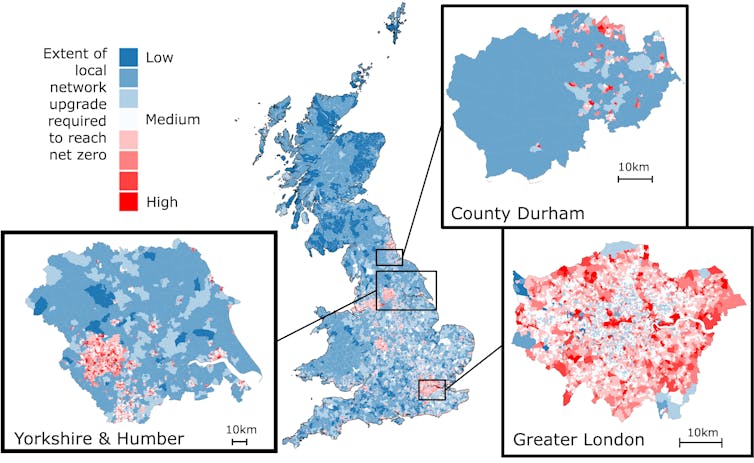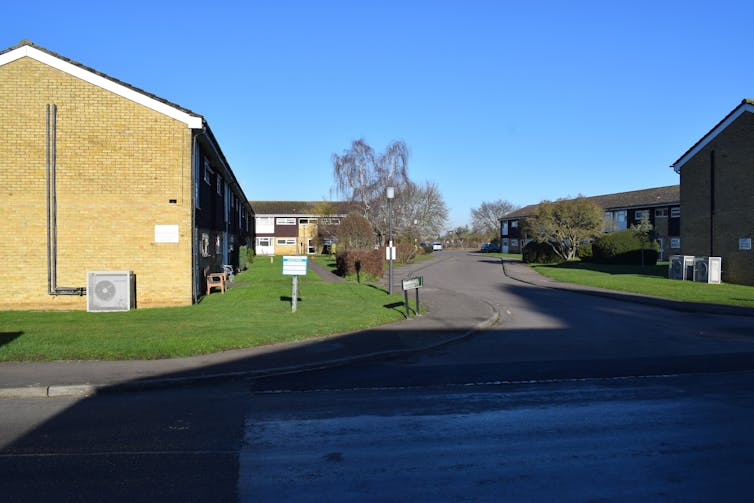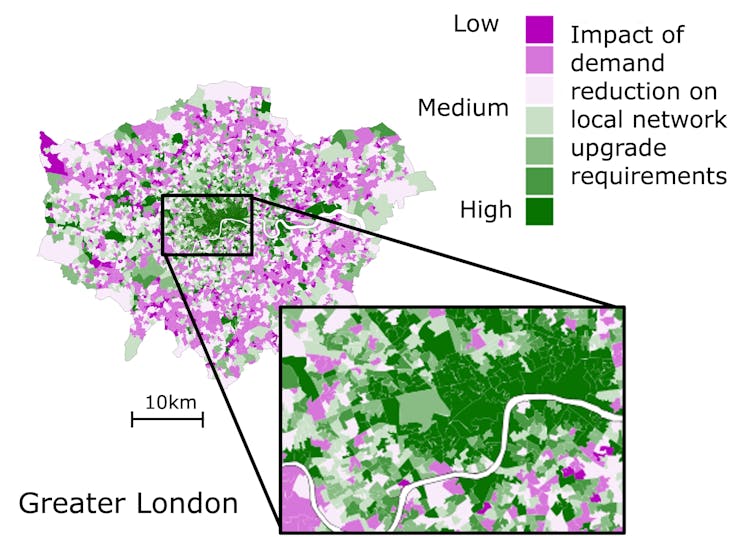To reduce its emissions in line with national and global targets, the UK must overhaul how it produces, uses and distributes electricity.
Millions of heat pumps, electric vehicles (EVs) and solar panels are planned in the UK. These can reduce emissions and lower household bills. However, they will also substantially raise the amount of power neighbourhoods need over coming decades, particularly during peak demand periods like early evening. At other times, when the Sun is shining and electricity use is low, solar panels on homes and businesses could allow neighbourhoods to export electricity to the network.
Much of the UK’s electricity network was built in the 1950s and needs upgrading to accommodate this level of electricity usage. Around 15% of cables and almost half of substations may need replacing to meet the UK’s net zero goal.
Understanding how this will affect electricity networks on a street-by-street level is challenging. Houses and businesses are distributed differently within areas. Likewise, electricity networks are configured differently and will serve varying numbers of electric appliances. This will all affect whether existing networks are able to handle changes to electricity demand, and the parts of these networks that need upgrading.
Grid upgrades will be most severe in cities
My colleagues and I have mapped the places where the grid is most likely to need upgrades in the transition to net zero. Our maps depict the density of homes and small businesses, the arrangement of existing cables and substations, and the quantity of heat pumps, EVs and solar panels – now and in the future.

Some areas have more public transport use and fewer cars, implying fewer EVs. Areas where heat networks are planned (pipes bringing hot water directly into homes from a central source like a power plant) are likely to see fewer heat pumps installed, whereas rural areas have more space for solar panels.
Some of this information was drawn from National Grid and other operators. The scenario our research paints is not assured – different regions may deploy more or less green technologies. For example, a local network operator may assume higher EV uptake than elsewhere, or a local authority may decide to focus on heat networks rather than heat pumps.
However, our modelling shows that necessary upgrades to local networks will be more widespread and costly in urban areas. Cables are longer and reach more households and businesses in cities, and there are fewer substations per household. These networks already transfer large amounts of electricity and are more likely to overload as demand for clean electricity grows.
What’s more, cables in rural areas typically run overhead with substations mounted on poles, making them easier to replace. In cities, the task is more difficult (and expensive) as cables usually run underground.

How the public can help
Network upgrades require labour and cost money. If there is a way to avoid doing this without obstructing the transition to a low-carbon energy system, it could save money and help to reduce emissions quicker.
In some places, increasing demand for clean electricity will push local networks far beyond their present capabilities, so upgrades will be the only option. But where networks are not overburdened, upgrades could be avoided by people reducing how much electricity they use during peak times. Households could shift when they charge an EV, wash clothes, vacuum or bake.
Another way to lower electricity demand is by increasing energy efficiency: switching to more efficient lighting and appliances, or insulating homes to allow for smaller heat pumps. Homes or small businesses with installed batteries or plugged-in EVs can set them up to automatically discharge stored power to the grid at peak times.
Households and businesses can already get discounts on their energy bills for doing this. This was successfully trialled to reduce renewable electricity demand at times when it is difficult to generate enough of it across the country, such as on winter evenings when there is little wind.

Similar schemes could provide additional discounts or pay households and businesses to reduce electricity use where networks are constrained. Our modelling suggests that reducing electricity use would be particularly effective in the most densely populated areas of central London.
Households and small businesses can play an important part in decarbonising the UK’s power network. Maps can show where these opportunities are in different regions, and help authorities see where they should be focusing their efforts in the race to meet the UK’s net zero emissions target.

Don’t have time to read about climate change as much as you’d like?
Get a weekly roundup in your inbox instead. Every Wednesday, The Conversation’s environment editor writes Imagine, a short email that goes a little deeper into just one climate issue. Join the 30,000+ readers who’ve subscribed so far.

